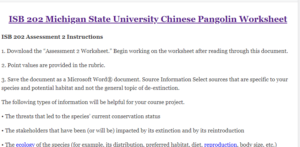ISB 202 Michigan State University Chinese Pangolin Worksheet
ISB 202 Michigan State University Chinese Pangolin Worksheet
ISB 202 Assessment 2 Instructions
1. Download the “Assessment 2 Worksheet.” Begin working on the worksheet after reading through this document.
2. Point values are provided in the rubric.
3. Save the document as a Microsoft Word® document. Source Information Select sources that are specific to your species and potential habitat and not the general topic of de-extinction.
The following types of information will be helpful for your course project.
• The threats that led to the species’ current conservation status
• The stakeholders that have been (or will be) impacted by its extinction and by its reintroduction
• The ecology of the species (for example, its distribution, preferred habitat, diet, reproduction, body size, etc.)
• The ecology of the preferred habitat (where would the species be reintroduced to and what is that habitat like- climate, biome, organisms currently present); after researching where it was found or can survive, it might be helpful to look up a suitable national park or other protected area.
ISB 202 Michigan State University Chinese Pangolin Worksheet

ISB 202 Michigan State University Chinese Pangolin Worksheet
• The evolutionary history (for example, its phylogenetic history, closest living relatives, where these species are found and their conservation status; body size and reproduction of closest relatives) Types of Sources This reference list will include sources that represent a variety of perspectives and stakeholders. Include at least five sources:
• At least two must be scholarly articles,
• One will be the IUCN Red List website or another website that you have been directed to on your species slip of paper, and • the remaining two can be other resources that are relevant. Note that these could be additional scholarly articles, an additional approved website (check with your instructor), a book, book chapter, a government document, or other authoritative source. Although not required, feel free to include more than five sources if you find more that might be helpful.
This will help further prepare you for your project.
Part 1: Annotations The following is a list of questions to be answered for each reference. These are answered in the corresponding worksheet found on D2L.
1. Which perspective(s) and stakeholder(s) do the author(s) represent? You may have to research the author(s) or organization to answer this question. Answer in one sentence.
2. Explain how you found the source. Is it an open-access source or is it limited by licensing/payment? Answer in one sentence.
3. How is the information packaged? Is it a website, scientific article, a secondary article, blog, etc.? Answer in one sentence.
4. Describe the credibility of the source, including how the source was found and the authority of the source. Answer in two to four sentences.
5. Explain how this source will be useful for your final project, which is evaluating the species’ candidacy for de-extinction. Answer in two to four sentences. ISB 202 Assessment 2 Instructions Bierema, Spring 2020
6. Describe how the source compares to the other sources that are in this annotated bibliography. Consider how the source confirms, conflicts with, or offers a new perspective on the information. Answer in two to four sentences. For each annotation, answer questions 1-3 in one sentence each, and answer questions 4-6 in two to four sentences. Minimize grammatical errors so that they do not distract the reader.
Use the “Assessment 2 Worksheet” to answer the questions.
Part 2: Stakeholder Web Most stakeholders are connected to each other, and these connections often lead to more intersections between stakeholders. After completing the annotated bibliography, draw a web showing the relationships between different stakeholders affected by your species.

